
- Home
- Meteora Monasteries, UNESCO World Heritage Site
- Posts
- Meteora Monasteries, UNESCO World Heritage Site
Meteora Monasteries, UNESCO World Heritage Site
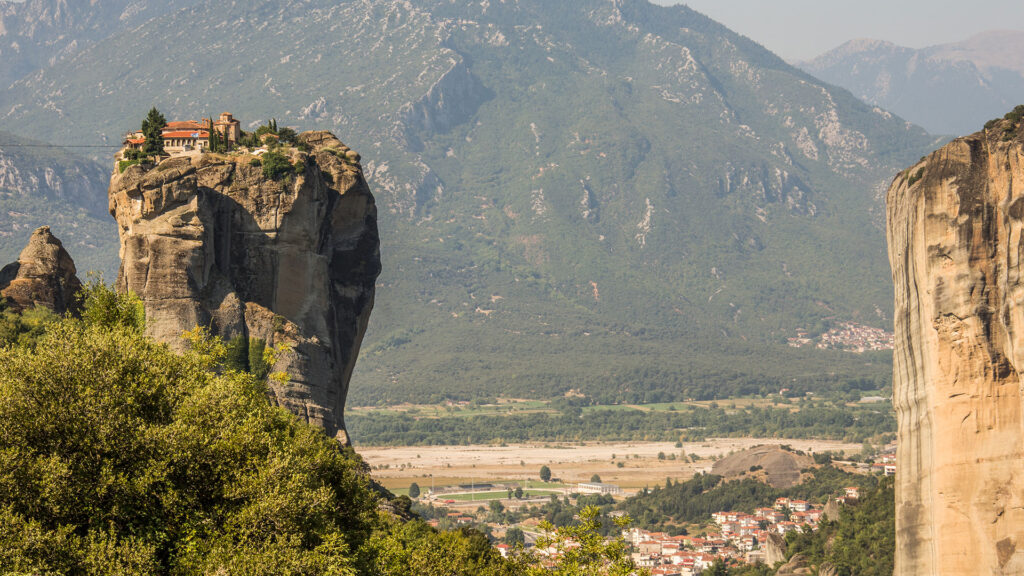
From the begining to today
A visit to Meteora-Greece and the monasteries offer a unique perspective of nature’s grandeur in conjunction with history, architecture, and man’s everlasting desire to connect with the Divine. From the early Christian times, the cliffs of Meteora were regarded as a perfect place to achieve absolute isolation. A place for people to find peace and harmony and, thus, to support mankind’s’ eternal struggle for spiritual ascension.
Meteora today is the largest archaeological site of Greece in terms of the area that it covers. It is also a UNESCO World Heritage Site since 1989 and an official holy place for Greece since 1995. A vast complex of giant rock pillars with monasteries made on the picks of the sandstone cliffs centuries ago creates a truly surreal landscape found nowhere else in the world!

The origins of Meteora Monasteries
The first ones who arrived in the area to use the cliffs of Meteora for spiritual reasons were Orthodox Christian hermit-monks. They came to this place between the 9th and the 10th century to find quiet and to isolate themselves in the many caves found scattered among the cliffs. For centuries those monks lived in complete isolation. Exposed to weather elements and to all sorts of dangers they relied heavily on the help of the locals. They will regularly receive donations of food, water, clothing, wood, essential things to allow them to survive. The locals saw them as holy men who came to dwell in the area, worthy of their support.
This early period becomes the first stage in the monastic development of Meteora, dominated by the ascetic figures of the first hermit monks, living unorganized and in isolation in the caves of the area. This first stage lasts for a couple of centuries, up until the 12th century, and the start of the second phase in the development of Meteora’s monastic tradition. The development of the organized skete of Doupiani in the 12th century marks an important milestone in the long development of monasticism here at Meteora.
Around the 12th century, a monk named Nilos decides to gather the scattered hermit monks of Meteora into a more organized monastic community. He set-up rules and cannons for the hermits of Meteora to follow. Thus initiating the second phase of a more organized monastic development at Meteora. The focal point of this first organized monastic community became the chappel of Doupiani, still found today standing beneath the synonymous cliff on the northwest side of Kastraki village. The hermit-monks of Meteora will gather every Sunday in the chapel of Doupiani to attend the Sunday service and to share provisions.
Two centuries later, in the 14th century, another monk named Athanasios climbed on the second-highest rock to establish the first monastery of Meteora, the Great Meteoron. He is regarded today as one of the most important figures in the long history of Meteora’s monasticism being the founder of one of the most important monastic communities of the Orthodox Church, second only to Athos. By the 16th century, at the hight of Meteora’s monastic community, the number of monasteries existing in the site had reached a total of 24.
The 16th century was by far the best period of Meteora monasteries. During that time we see the largest population of monks and the biggest number of active monasteries. A century later, in the 17th century, the downfall came and for the next 3 centuries, Meteora monasteries constantly decline. Today and out of the initial 24 monasteries, only 6 remain active.
Let’s meet the six Monasteries
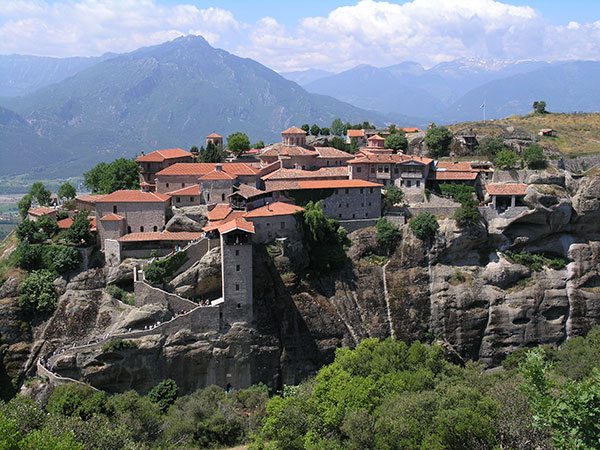
The Monastery of Great Meteoron
The first monks of Meteora arrived back in the 14th century establishing the Meteora monasteries on top giant cliffs. They chose to do this not because it was easy but because it was hard, almost impossible. And they succeeded in this great achievement to build them through their great faith.
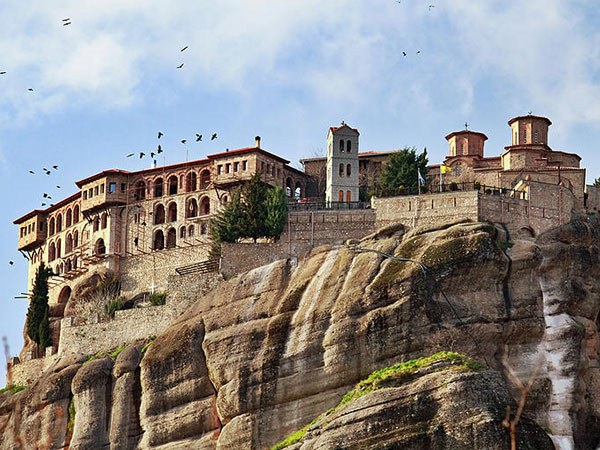
The Monastery of Varlaam
The monks separated themselves from this world; fleeing into the deserts, crossing the seas, climbing on steep and high mountains. They stop at nothing in their everlasting desire to witness the Divine Light; to experience the presence of God in their hearts.
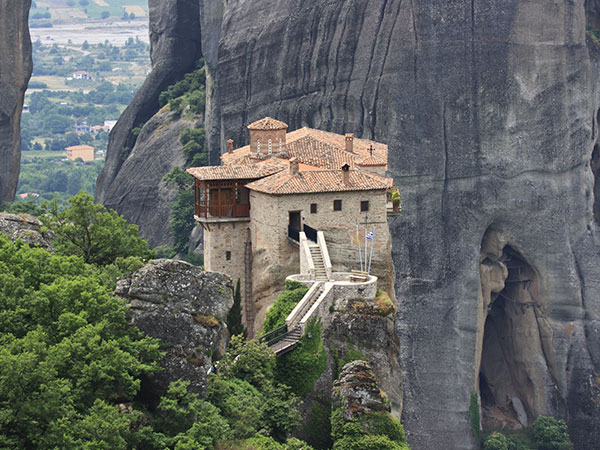
The Monastery of Roussanou
The monks separated themselves from this world; fleeing into the deserts, crossing the seas, climbing on steep and high mountains. They stop at nothing in their everlasting desire to witness the Divine Light; to experience the presence of God in their hearts.

The Monastery of St. Stephen
Humble men lived suspended for centuries between the heavens and earth, perched on the edge of sharp cliffs, glorifying God for He made the earth and heavens by His power. They achieved the impossible of building Meteora monasteries
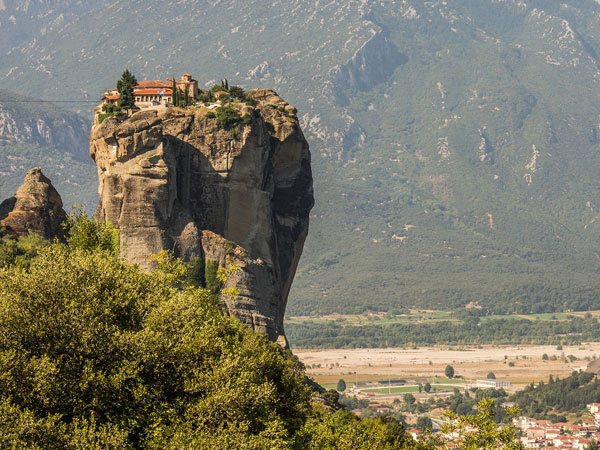
The Monastery of Holy Trinity
The sea is His, for it was He who made it, and His hands formed the dry land and the high mountains. And men of faith then came and curved the rocks and conquered the mountains, creating temples in the Holy Monasteries of Meteora for the worship of their God
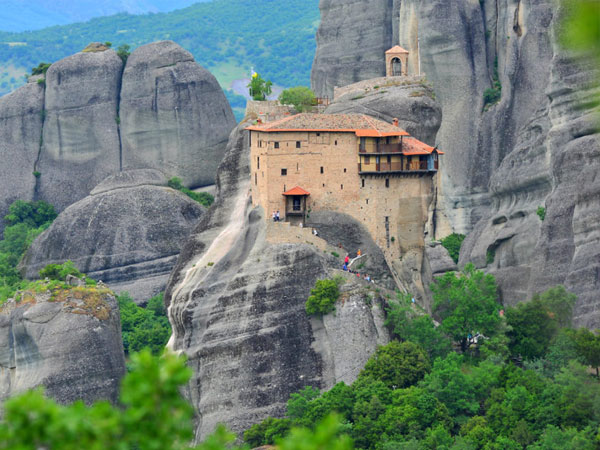
The Monastery of St. Nikolaos
…there is something majestic in the power and firmness of their faith. They have left their homes, the riches and pleasures of this world in order to grow old in these nests and caves of this earth, to suffer from cold and hunger, pain and death, perhaps to honor their God in this way…
The Monasteries of Meteora today
The six active Meteora monasteries create a truly inspiring and sensational setting of overwhelming rock formations with these ancient monuments occupying their picks. In essence, Meteora today has become a preservation ark for the 2000-year-old Christian Orthodox creed. Today, out of initially 24 monasteries that used to exist, only 6 remain active for people to visit.
Out of those 6 active monasteries, 2 of them (Agios Stefanos & Roussanou) are convents with nuns and the rest 4 are male monasteries with monks. In total, today there are approximately 50 nuns and 17 monks still living in the active monasteries of Meteora.
If you wish to plan for a visit to the monasteries make sure if you haven’t done it yet, to read our blog post about the important things you should know before you plan your trip. There you will also find details about the dress code required for men and women, as well as the opening hours of monasteries. In that same article, we also discuss the accessibility of each monastery and why it’s not always a good idea to drive your car especially during the pick period in the Summer.
Visiting Hours and Opening Days of Meteora Monasteries
Check here the summer or winter timetables for the visiting hours and days of Meteora Monasteries. The dates you see below, separating each main season are somewhat indicative. Expect minor changes to occur on these dates during the seasonal transition from Winter to Summer timetable on each different monastery. Meteora-Greece is a UNESCO World Heritage site visited every year by almost 2 million people!
Be aware that although we try our best to keep the timetable of Meteora monasteries updated as much as possible, we are not responsible for any sudden changes to the visiting hours and days the monks might decide. The Monasteries of Meteora can change the opening hours and days without any prior notice!
Monasteries Summer Timetable
(April 1st to October 31st)
- St. Stephen’s Nunnery
Visiting Hours: 9:00 to 13:30 and 15:30 to 17:30.
The monastery stays closed on Mondays. - Great Meteoron Monastery
Visiting Hours: 09:00 to 15:00.
The monastery stays closed on Tuesdays. - Roussanou Monastery
Visiting Hours: 10:00 to 16:00.
The monastery will follow the above hours from June to September.
From March to the end of May it will close earlier at either 16:00 or 15:00.
The monastery stays closed every Wednesday. - Holy Trinity Monastery
Visiting Hours: 10:00 to 16:00.
The monastery stays closed on Thursdays. - Varlaam Monastery
Visiting Hours: 09:00 to 16:00.
The monastery stays closed on Fridays. - Agios Nikolaos Anapafsas Monastery
Visiting Hours: 09:00 to 17:00.
The monastery is open every day.
Monasteries Winter Timetable
(November 1st to March 31st)
- St. Stephen’s Nunnery
Visiting Hours: 9:30 to 13:00 and 15:00 to 17:00.
The monastery stays closed on Mondays. - Great Meteoron Monastery
Visiting Hours: 09:30 to 14:00.
The monastery stays closed on Tuesdays, Wednesdays, and Thursdays. - Roussanou Monastery
Visiting Hours: 10:00 to 14:00.
The monastery stays closed on Wednesdays. - Holy Trinity Monastery
Visiting Hours: 10:00 to 16:00.
The monastery stays closed on Thursdays. - Varlaam Monastery
Visiting Hours: 09:00 to 15:00.
The monastery stays closed on Thursdays and Fridays. - Agios Nikolaos Anapafsas Monastery
Visiting Hours: 09:00 to 16:00, Sundays: 9:30 to 16:00.
The monastery is open every day.
Comments
Add a comment
Leave a Reply · Cancel reply
You must be logged in to post a comment.
